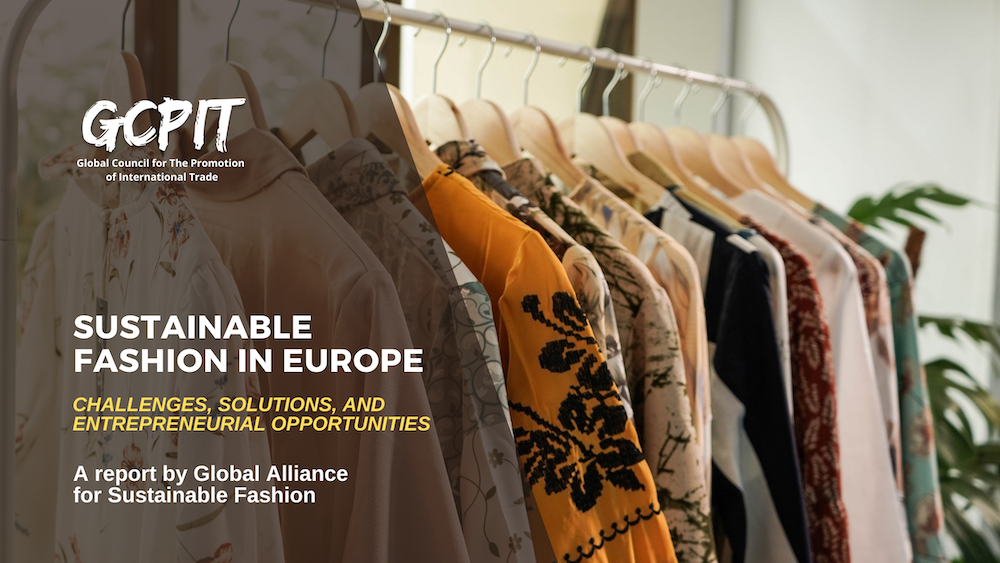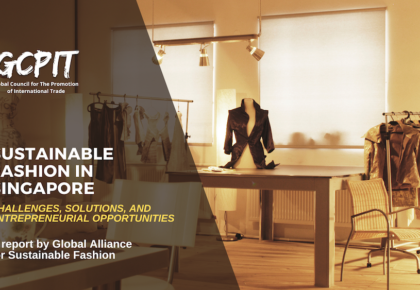
The fashion industry is one of the most polluting industries globally, and the need for sustainable fashion has never been more crucial. Sustainable fashion aims to minimize the negative impacts of the fashion industry on the environment and society by creating a circular and ethical production system. Europe, being one of the major fashion hubs in the world, faces significant challenges in implementing sustainable fashion practices. This case study aims to identify the challenges faced by Europe in sustainable fashion, the solutions that have been implemented, the opportunities for entrepreneurs in sustainable fashion, and the outcomes of these solutions.
Challenges: Europe is a major fashion hub, and the fashion industry plays a significant role in its economy. However, the fashion industry is also one of the most polluting industries globally, and the need for sustainable fashion has never been more crucial. Sustainable fashion aims to minimize the negative impacts of the fashion industry on the environment and society by creating a circular and ethical production system. Europe faces significant challenges in implementing sustainable fashion practices. This section aims to identify the top ten challenges faced by Europe in sustainable fashion.
-
Fast fashion: The fast fashion culture has resulted in an increase in textile waste, which has a significant impact on the environment. The average person in Europe throws away 11kg of clothing per year, and only 25% of that is recycled or reused.
- Overproduction: The fashion industry is notorious for overproduction, which results in excess waste and a negative impact on the environment. In Europe, around 4 million tonnes of clothing are thrown away every year.
- Water usage: The fashion industry is a significant contributor to water pollution and water usage. It takes an average of 2,700 liters of water to make one cotton t-shirt, and the textile dyeing and finishing process is responsible for 17-20% of industrial water pollution.
- Chemical usage: The fashion industry uses a vast amount of chemicals, including pesticides and fertilizers, which have a significant impact on the environment and human health.
- Labor exploitation: The fashion industry is infamous for its exploitation of labor, particularly in developing countries. European companies often outsource production to developing countries where labor laws and regulations are lax.
- Lack of transparency: Many fashion companies do not disclose information about their supply chain, making it challenging to determine whether their practices are sustainable and ethical.
- Greenwashing: Some fashion companies claim to be sustainable but engage in greenwashing, where they exaggerate or mislead consumers about their sustainability practices.
- Consumer behavior: Consumer behavior plays a significant role in the fashion industry’s sustainability. The fast fashion culture has led to an increase in clothing consumption, which results in excess waste and a negative impact on the environment.
- Recycling challenges: Recycling textile waste is challenging due to the wide range of materials used in the fashion industry and the lack of infrastructure for recycling.
- Limited access to sustainable fashion: Sustainable fashion is often more expensive than traditional fashion, making it inaccessible to many consumers. Additionally, sustainable fashion options are not always readily available in the market.
Key Statistics:
- The fashion industry is responsible for 10% of global carbon emissions.
- It takes an average of 3,781 liters of water to make one pair of jeans.
- Only 1% of clothing is recycled into new clothing.
- The fashion industry produces 92 million tons of waste per year.
- 93% of fashion brands do not pay a living wage to workers in their supply chain.
- The fashion industry is responsible for 20% of global wastewater.
- The production of one kilogram of cotton requires up to 20,000 liters of water.
Solutions Implemented by the Country: Sustainable fashion has become an increasingly important topic in the fashion industry, with a growing number of countries implementing measures to promote sustainability in fashion. The European fashion industry has been particularly active in this regard, with several countries implementing unique solutions to address the challenges facing sustainable fashion. From circular design and production to sustainable supply chain management, digital innovation, and ethical fashion, European countries have implemented a variety of solutions to promote sustainability in the fashion industry.
- Circular Design and Production: Several European countries have implemented circular design and production processes in the fashion industry. This includes the use of sustainable materials, such as recycled fabrics and upcycling, and closed-loop production processes. For example, in Denmark, the Circular Fashion Partnership was launched in 2020 to support circular fashion initiatives.
- Eco-Labels and Certification: Eco-labels and certifications are an effective way to provide transparency in the fashion industry and promote sustainable practices. Several European countries have implemented such certifications, such as the EU Ecolabel, Nordic Swan Ecolabel, and GOTS (Global Organic Textile Standard) certification. In Germany, the Grüner Knopf (Green Button) certification was launched in 2019 to promote sustainable textile production.
- Sustainable Supply Chain Management: Ensuring sustainability across the entire supply chain is a crucial aspect of sustainable fashion. Several European countries have implemented measures to promote sustainable supply chain management, such as France’s Loi sur le devoir de vigilance (Duty of Vigilance Law) and the UK’s Modern Slavery Act.
- Collaborative Initiatives: Collaboration between stakeholders in the fashion industry is essential to achieving sustainability goals. Several European countries have implemented collaborative initiatives, such as the Dutch Agreement on Sustainable Garments and Textile and the Swedish Textile Initiative for Climate Action.
- Slow Fashion Movement: The slow fashion movement promotes sustainable and ethical fashion through promoting quality over quantity, and the use of sustainable materials and production processes. Several European countries have implemented measures to promote the slow fashion movement, such as France’s Les Filieres (The Channels) initiative.
- Digital Innovation: Digital innovation is being increasingly used in the fashion industry to promote sustainability, such as through the use of blockchain technology for supply chain transparency. The European Union has also launched the Digital Europe Programme, which supports digital innovation in the fashion industry.
- Sustainable Fashion Education: Education is a crucial aspect of promoting sustainable fashion. Several European countries have implemented sustainable fashion education initiatives, such as the Swedish School of Textiles and the London College of Fashion’s Centre for Sustainable Fashion.
- Second-Hand and Rental Fashion: The promotion of second-hand and rental fashion is an effective way to reduce the environmental impact of the fashion industry. Several European countries have implemented measures to promote second-hand and rental fashion, such as the Netherlands’ Kledingbibliotheek (Clothing Library) initiative.
- Ethical Fashion: Ethical fashion promotes fair labor practices and social responsibility in the fashion industry. Several European countries have implemented measures to promote ethical fashion, such as the Ethical Trading Initiative in the UK and the Fair Wear Foundation in the Netherlands.
- Sustainable Fashion Events and Campaigns: Sustainable fashion events and campaigns are an effective way to raise awareness about sustainable fashion and promote sustainable practices. Several European countries have implemented such initiatives, such as the Berlin Fashion Week’s focus on sustainable fashion and the Copenhagen Fashion Summit.
According to a report by the Ellen MacArthur Foundation, the European fashion industry produces 1.3 million tons of textile waste each year, with only 12% of clothing being recycled. Additionally, the fashion industry is responsible for 8-10% of global carbon emissions and 20% of global wastewater. However, the European Union has set a goal to become climate-neutral by
Opportunities for entrepreneurs: Entrepreneurship has a significant role to play in promoting sustainable fashion in Europe. It is not only an opportunity for entrepreneurs to make a positive impact on society and the environment but also a way to tap into a growing market. Sustainable fashion is gaining popularity among consumers, and entrepreneurs can leverage this trend to develop new business models and products that address the challenges facing the fashion industry. Here are ten unique opportunities for entrepreneurs to contribute to sustainable fashion in Europe.
- Circular Fashion: The circular fashion model aims to minimize waste and pollution by keeping materials in use for as long as possible. Entrepreneurs can take advantage of this opportunity by developing business models that incorporate circularity. For instance, companies like Worn Again Technologies and Renewcell are using technology to recycle textile waste and transform it into new fibers for the fashion industry.
- Sustainable Materials: Entrepreneurs can focus on developing new sustainable materials for the fashion industry. For instance, Pinatex is a company that has developed a leather-like material made from pineapple leaf fibers. This material is not only sustainable but also cruelty-free, making it an attractive alternative to traditional leather.
- Green Logistics: The fashion industry’s supply chain is known to have a significant environmental impact, with transportation being a significant contributor. Entrepreneurs can develop green logistics solutions to reduce the carbon footprint of the fashion industry. For example, companies like MUD Jeans are using electric vehicles to deliver their products, reducing emissions and contributing to sustainable fashion.
- Ethical Fashion: Ethical fashion focuses on promoting fair and safe working conditions for fashion workers. Entrepreneurs can take advantage of this opportunity by developing business models that prioritize ethical fashion. For example, companies like People Tree and Armed Angels are using fair trade and organic cotton to create sustainable and ethical fashion products.
- Slow Fashion: The slow fashion movement promotes a more sustainable approach to fashion by encouraging consumers to buy fewer, high-quality pieces and use them for longer. Entrepreneurs can develop business models that prioritize slow fashion by creating timeless designs that are made to last. For example, companies like Patagonia and Nudie Jeans are known for creating high-quality, durable clothing that is made to last.
- Renting and Sharing Platforms: Entrepreneurs can take advantage of the growing trend of renting and sharing clothing by developing platforms that facilitate these transactions. For example, companies like Rent the Runway and Tulerie are offering consumers the option to rent high-end designer clothing for a fraction of the cost of buying.
- Upcycling: Upcycling involves transforming old or unwanted clothing into new products, reducing waste and promoting sustainability. Entrepreneurs can develop business models that incorporate upcycling, like companies such as Rapanui and TRMTAB, which are creating new clothing from old garments.
- Transparency: Consumers are increasingly demanding transparency from fashion brands, including information about the materials used, manufacturing processes, and the impact on the environment and society. Entrepreneurs can develop business models that prioritize transparency, like companies such as Everlane and Honest by, which provide detailed information about their supply chain and production processes.
- Sustainable Packaging: Entrepreneurs can develop sustainable packaging solutions to reduce the environmental impact of the fashion industry. For example, companies like Paptic and Ecovative Design are using innovative materials like mushroom-based packaging and bioplastics to create sustainable packaging solutions for fashion products.
-
Sustainable Accessories: Accessories such as shoes, bags, and jewelry can also have a significant impact on the environment and society. Entrepreneurs can focus on developing sustainable accessories that prioritize social and environmental responsibility. For example, companies like Veja and Matt & Nat are creating sustainable and ethical shoes and bags that use recycled materials and prioritize fair working conditions.
Outcome of the Solutions Implemented: Europe has been a leader in sustainable fashion with many innovative solutions implemented in recent years. The efforts of the European Union and various organizations have created a shift in the fashion industry towards sustainable and circular practices. These solutions have resulted in positive outcomes such as reduced waste and pollution, improved working conditions, and increased consumer awareness. In this section, we will discuss the top 10 unique outcomes of sustainable fashion solutions implemented in Europe.
- Reduced carbon footprint: The use of sustainable materials such as organic cotton, recycled polyester, and Tencel has reduced the carbon footprint of the fashion industry in Europe. For example, according to the European Clothing Action Plan, the use of sustainable materials in the UK could reduce carbon emissions by 3.2 million tonnes by 2030.
- Increased recycling: The implementation of circular practices such as closed-loop recycling systems has resulted in increased recycling of textiles. The European Clothing Action Plan has set a target to increase textile collection for reuse and recycling by 90,000 tonnes by 2019.
- Improved working conditions: The focus on sustainability has led to improved working conditions for workers in the fashion industry. The Fair Wear Foundation, an independent organization, works with brands to ensure that workers are paid fairly and work in safe conditions.
- Increased transparency: The use of blockchain technology and other traceability solutions has increased transparency in the fashion industry. Consumers can now trace the origin of materials used in the production of their clothes, leading to increased trust in brands.
- Increased demand for sustainable fashion: Consumers in Europe are increasingly aware of the impact of their clothing choices on the environment and society. The demand for sustainable fashion has increased, leading to more brands offering sustainable options.
- Reduced waste: The implementation of circular practices such as upcycling, recycling, and the use of waste as a resource has reduced waste in the fashion industry. For example, the H&M Conscious Collection uses recycled and organic materials and has diverted over 39,000 tonnes of waste from landfills.
- Increased innovation: The focus on sustainable fashion has led to increased innovation in the industry. Brands are developing new materials and production processes that are more sustainable and less harmful to the environment.
- Improved biodiversity: The use of organic materials has improved biodiversity in the areas where they are grown. For example, organic cotton farming uses fewer pesticides, which leads to improved soil health and biodiversity.
- Reduced water usage: The fashion industry is one of the largest consumers of water globally. The implementation of sustainable practices such as using water-efficient dyeing processes has reduced the amount of water used in the production of clothes.
- Increased collaboration: The focus on sustainable fashion has led to increased collaboration between brands, organizations, and governments. The European Clothing Action Plan, for example, is a multi-stakeholder initiative that aims to reduce the environmental impact of clothing across Europe.
Implication of Private-public partnerships, alliances, and collaborations on country’s good health and wellbeing sector: In Europe, private-public partnerships, alliances, and collaborations have played a significant role in advancing sustainable fashion practices. These partnerships have brought together stakeholders from across the industry, including fashion brands, policymakers, NGOs, and academics, to share knowledge, resources, and best practices.
One notable example is the European Clothing Action Plan (ECAP), a four-year project funded by the European Union that brought together 12 organizations from across Europe to reduce textile waste and promote sustainable fashion practices. Through ECAP, partners collaborated to develop and implement a range of innovative solutions, such as circular design principles, product-service systems, and textile-to-textile recycling technologies.
According to a report by ECAP, the project’s impact has been significant, with an estimated 543,000 tonnes of carbon dioxide equivalent emissions saved and 5,000 tonnes of textiles diverted from landfill. Additionally, the project has helped to create over 700 new jobs and generate over €10 million in revenue.
Another example is the Fashion for Good initiative, a global platform that aims to accelerate the transition to a more sustainable fashion industry through collaboration, innovation, and investment. Fashion for Good brings together brands, manufacturers, NGOs, and investors to share knowledge and resources and develop new solutions for sustainable fashion. Since its launch in 2017, Fashion for Good has supported over 160 innovators and entrepreneurs and facilitated the adoption of sustainable practices by leading fashion brands.
In addition, the Sustainable Apparel Coalition (SAC) is a membership-based organization that includes brands, retailers, manufacturers, and NGOs working to reduce the environmental and social impacts of the apparel and footwear industry. The SAC has developed the Higg Index, a suite of tools that helps companies measure and improve their sustainability performance across the entire value chain. As of 2021, over 300 companies have used the Higg Index to assess their sustainability performance.
Overall, private-public partnerships, alliances, and collaborations have been essential in advancing sustainable fashion practices in Europe. By bringing together diverse stakeholders and leveraging their collective knowledge and resources, these partnerships have been instrumental in developing and implementing innovative solutions and driving systemic change.
Conclusion: The fashion industry has a significant impact on the environment and society, making it imperative to transition towards sustainable fashion practices. The challenges faced by the industry include high demand for fast fashion, lack of transparency and traceability, inefficient resource use, and poor working conditions in the supply chain. However, European countries have implemented various solutions, such as recycling, circular design, and sustainable sourcing, to address these challenges. Entrepreneurs have also identified opportunities in sustainable fashion, including eco-friendly textiles, sustainable production techniques, and innovative business models. The outcomes of these solutions include a reduction in waste and emissions, increased resource efficiency, and improved working conditions in the supply chain.
Moreover, private-public partnerships, alliances, and collaborations have played a vital role in promoting sustainable fashion practices in Europe. Organizations such as the Global Fashion Agenda, Sustainable Apparel Coalition, and Ellen MacArthur Foundation have brought together various stakeholders to drive systemic change in the industry. Collaborations between fashion companies and tech startups have also resulted in the development of innovative solutions for sustainable fashion.
Despite the progress made, there is still a long way to go to achieve a fully sustainable fashion industry in Europe. It is crucial for stakeholders to continue collaborating and investing in sustainable solutions. Governments can also play a role in supporting sustainable fashion practices by incentivizing sustainable practices and regulating unsustainable ones.
According to the European Environmental Agency, the EU generated approximately 16.7 million tonnes of textiles waste in 2017, with only 25% being recycled or reused. Furthermore, it is estimated that the fashion industry contributes 5% to global greenhouse gas emissions, and the production of one cotton shirt requires 2,700 litres of water. These statistics highlight the urgent need for the fashion industry to transition towards sustainable practices.
On a positive note, the demand for sustainable fashion is increasing, with consumers becoming more aware of the environmental and social impacts of their purchases. A survey by Fashion Revolution found that 75% of consumers would boycott a brand if they found out it was not paying workers a fair wage. Furthermore, 48% of consumers are willing to pay more for sustainable fashion products.
Sustainable fashion is not just a trend but a necessity for the fashion industry. European countries have made significant progress in addressing the challenges faced by the industry through various solutions and collaborations. Entrepreneurs have also identified opportunities in sustainable fashion, leading to innovative solutions that have positively impacted the industry. However, there is still a long way to go to achieve a fully sustainable fashion industry, and stakeholders must continue to collaborate and invest in sustainable practices to drive systemic change.
Call to action: As we have explored throughout this report, the sustainable fashion industry in Europe is facing a number of challenges that require the collective effort of various stakeholders to address. From improving supply chain transparency to reducing waste and promoting circularity, there is a lot of work to be done to ensure that the industry operates in a way that is both socially and environmentally responsible.
Therefore, we call on all stakeholders in the sustainable fashion industry in Europe to collaborate and take action. Governments, businesses, consumers, and civil society organizations all have a role to play in making the industry more sustainable. By working together, we can achieve the following goals:
- Increase supply chain transparency and traceability: By collaborating with stakeholders at all levels of the supply chain, we can ensure that the materials used in fashion products are sourced responsibly and that workers are treated fairly.
- Promote circularity and reduce waste: Through innovative business models, such as rental and resale platforms, we can extend the life of fashion products and reduce the amount of waste generated by the industry.
- Support sustainable production practices: By investing in research and development, and promoting sustainable manufacturing practices, we can reduce the environmental impact of textile production and promote the use of renewable energy sources.
- Educate consumers on sustainable fashion: By increasing consumer awareness and providing information on sustainable fashion, we can empower consumers to make more informed choices when purchasing fashion products.
- Foster collaboration between stakeholders: Through public-private partnerships, alliances, and collaborations, we can create a more coordinated and effective approach to promoting sustainable fashion.
We urge all stakeholders to take action and work together towards a more sustainable fashion industry in Europe. By doing so, we can promote the health and wellbeing of our citizens, protect the environment, and build a more resilient and sustainable economy. Let us take this opportunity to create positive change and build a brighter future for generations to come.
References
- European Clothing Action Plan. (n.d.). About ECAP. https://www.ecap.eu.com/about-ecap/
- Ellen MacArthur Foundation. (2017). A new textiles economy: Redesigning fashion’s future. https://www.ellenmacarthurfoundation.org/assets/downloads/publications/A-New-Textiles-Economy_Full-Report.pdf
- Sustainable Apparel Coalition. (n.d.). About us. https://apparelcoalition.org/about/
- European Commission. (2020). Sustainable products initiative. https://ec.europa.eu/environment/eussd/sustainable_products_en.htm
- Circular Fibres Initiative. (n.d.). About. https://www.circularfibres.org/about/
- C&A Foundation. (n.d.). What we do. https://www.candafoundation.org/what-we-do
- Textile Exchange. (n.d.). Our work. https://textileexchange.org/our-work/
- Fashion Revolution. (n.d.). Who we are. https://www.fashionrevolution.org/about/who-we-are/
- Better Cotton Initiative. (n.d.). Our story. https://bettercotton.org/about-bci/our-story/
- ECAP. (2019). ECAP final report. https://www.ecap.eu.com/wp-content/uploads/2019/10/ECAP-Final-Report.pdf








